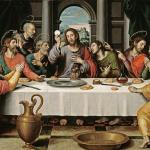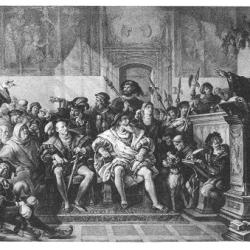Part Six: Pro-Life Rescue Movement, Letter to Karl Keating, My Ecumenical Gatherings, & the First “Domino”: Contraception (1988-1990)

This is the ten-part story of my complete religious history, from nominal Methodism (1958-1967), to the occult and practical atheism (1968-1976), through evangelical Protestantism, counter-cult, pro-life, evangelistic, and apologetics work (1977-1990), and finally on to the fullness of the Catholic faith in 1991. It is found complete (75 pages) in my 2013 book, Catholic Converts and Conversion.
See All Ten Parts:
Part One: Nominal Methodism, Occult, and the Seeds of a Serious Christian Commitment (1958 – early 1970s)
Part Two: Nature Mysticism, Romanticism, Bible Movies, and the “Great Depression” (1968-1977)
Part Three: Evangelical “Born-Again” (?) Experience, More Lukewarmness, and Personal Revival (1977-1982)
Part Four: Apologetics, Abundant Evangelical Blessings, and Protestant Evangelistic Campus Ministry (1983-1989)
* * * * *
Pro-Life Activism and Meeting Serious Catholics (1988-1990)
The other major activity in my life in the late 80s, and one that God directly used to bring me to the Catholic Church, was the pro-life movement, and eventually Operation Rescue. I picketing abortion clinics and tried to talk to people about the issue: sometimes with the help of posters, showing what abortion was. If someone objected to photographs of slaughtered preborn babies, I had a second poster that had only living preborn babies. If they complained about that, I’d ask, “so you object to biology?”
I started participating in blocking abortion clinic doors (thus, literally saving some preborn babies’ lives), in November 1988. According to a True to Life Bulletin that I sent out to my ministry supporters (22 June 1989), I was very actively involved in various pro-life activities from November 1988 to May 1989.
I was arrested in November 1988, and March and April 1989 for blocking clinic doors, and risked arrest in five other rescues up through June 1989. By 1990, I had participated in about 25 rescues (including a national one in Washington, D. C.), with five arrests. I went through three trials: one was dismissed; in another we were found not guilty, and in a third, we were found guilty and sentenced to a week in jail.
I stood up in court after being sentenced and noted that abortion was wrong even by pagan Greek standards and not simply a matter of “Bible-thumping fundamentalists”; that the “father of medicine,” Hippocrates (no Christian) had condemned it before Christ. I was put in a nice suburban jail cell (alone) for the night and let out promptly in the morning. That was my entire penalty for all my rescues. It was well-worth it because we know beyond a doubt that many babies were saved as a result of our efforts. Women had changed their minds.
It quickly became apparent to me that the Catholic rescuers were just as committed to Christ and godliness as evangelicals. In retrospect, there is no substitute for the extended close observation of devout Catholics. I had met countless evangelicals who exhibited what I thought to be a serious walk with Christ, but rarely ever Catholics of like intensity.
Generally speaking, Catholics are abysmally, shamefully, shockingly ignorant of their faith, and fervent Protestants know this full well. It’s a major reason why they don’t think too highly of Catholicism. When I finally did meet Catholics in the pro-life movement who could and would share and defend their faith, it was so fascinating to me that it led me to extensive discussions, study, and ultimately conversion. Curiosity may have killed the cat, but it sure helped me!
The same thing could have easily happened many years before if only a Catholic had taken the initiative to defend and explain his or her faith to me. Catholicism is, we believe, the fullness of Christian truth; yet (oddly enough) Catholics do such a poor job of proclaiming, defending, and living out that faith.
I began to fellowship with my Catholic brethren at rescues, and sometimes in jail, including priests and nuns. Although still unconvinced theologically, my personal admiration for orthodox Catholics skyrocketed. In one of the rescues (in Toledo, Ohio), I had Rosary beads around my neck, to the delight of some of my Catholic friends.
My Letter to Karl Keating in February 1990
I wrote to Catholic apologist Karl Keating (who began Catholic Answers), on 25 February 1990, near the beginning of my serious study of Catholicism. The letter gives clear indication of my still solidly evangelical Protestant state of mind at this time, and the nature of my primary objections to Catholicism. I described my ecumenical outlook:
I am an evangelical with growing and sincere respect for Roman Catholics, largely due to my increased communion with them by virtue of the Operation Rescue movement . . . I consider Catholicism as a fully Christian faith . . . I am, with you, disgusted and scandalized by works such as Boettner’s and Jack Chick’s and all such ilk, which, if any works deserve to be censored, certainly qualify in the highest degree.
I objected to a subtle insinuation I had perceived (rightly or wrongly) in Keating’s book, to the effect that Jehovah’s Witnesses were a species of Protestantism, and made an argument that if they were similar to any Christian groups, it was Catholicism. I concluded:
The idea of sola Scriptura and individual conscience and study would release thousands of JW’s from their spiritual bondage to false and deceitful leaders. But if it’s so clear that a JW should “check up” on the validity of his leaders by reading the Bible, why should this not be the case with Catholics?
I then strongly objected to an article by William Reichert, entitled “I will be where Peter is,” in This Rock, January 1990. I responded to two paragraphs that I described as “logically outrageous,” “rather foolish,” and guilty of “unfounded and illogical conclusions.” I stated that Riechert “betrayed a fundamental misunderstanding of what exactly perspicuity is.” To illustrate what it was, I cited the Presbyterian theologian Charles Hodge, backed up with two citations each from St. John Chrysostom and St. Augustine. I wrote:
Therefore, differences over “minor” matters not necessary to salvation do not cast doubt on the concept of perspicuity by definition. Protestants are merely allowing freedom of diversity on matters such as church government, modes of baptism, views on the Lord’s Supper, worship style and liturgy, etc. On central doctrines, we are indeed unified (God, man, salvation, biblical authority). So we have unity as Christians, at the same time allowing for differences of opinion on non-crucial items, and we all mutually recognize one another as part of the Body of Christ — something Catholics cannot comprehend because of their different view that the Church is equivalent to an ecclesiastical organization — i.e., Roman Catholicism.
The falsity of that view is well dealt with by Calvin in Book IV of his Institutes. Although it is unfortunate that denominations (usually smaller ones) do split over much more trivial matters than those mentioned above (due to sin, to be sure, on someone’s part), I still prefer this state of affairs to the purely formal “unity” Catholics have.
In theory, no diversity on doctrine is allowed, but in practice, you well know (and I’m familiar with enough Church history) that there is much dissension held privately — notable examples today being widespread Catholic dissent concerning contraception, abortion, and even fornication, but particularly the first, because it is so summarily and disobediently broken. Likewise, theological liberalism looms large in Catholicism, despite this supposed “unity” you claim.
Human nature is everywhere the same, and there will be diversity of opinion, whether due to illogic, different perspectives, evil, conscience, or whatever. We recognize it and allow for its expression, within certain bounds, whereas you attempt to deny and suppress it, which only causes it to flourish and become rebellious in spirit (I see this in countless young former Catholics whose questions were ignored).
Further, it is true that many will differ due to ignorance (Hodge: “things hard to understand”) or evil (Hodge: “all men need the guidance of the Holy Spirit”). These are not incredible assertions nor are they peculiar to Protestants, and they are quite consistent with perspicuity rightly understood, as opposed to the caricature of it by Reichert. The least one can do in “refuting” a position is to portray it accurately (another “straw man”).
Catholics recognize the same two factors in their distinction between formal and material heresy, denoting evil and ignorant differences from Catholic Dogma respectively. I can’t resist mentioning in passing the case of Galileo, whose views which were condemned as heresy were neither ignorant nor evil — far from either, whereas his accusers were obviously ignorant and arguably evil as well.
. . . for us, unity is not “a joke.” For the invisible Church is a far more profound unity than a merely formal, artificial, organizational unity, as it is comprised of those truly in Christ, including those now with the Lord — somewhat like your “communion of saints.” You might say we value individual conscience and standing under God more than the unity you aspire to — in fact, we regard separation from a group with which we cannot agree as a duty, not as a dreaded “schism” — far preferable to the specter of millions of Catholics refusing to honestly acknowledge that they are not “true” or “good” Catholics.
. . . The fundamental disagreement between Catholics and Protestants is, I believe, the issue of apostolic succession, tradition, and its corollary, infallibility. Therefore, I’ve set out to show that Catholicism has in fact not been infallible historically, by means of clear logical contradictions and instances of undoubted heresy. If this is shown, then the whole edifice collapses, and you are on the same ground as we are. I think that such an utterly extraordinary and remarkable claim as infallibility must be prepared to meet objections of example seemingly contradictory to that claim. Thus, out of motives of sincere inquiry and interest, I seek your assistance on that score. Thanks so much for your time.
With respect and sincerity,
Dave Armstrong
The Providential Group Discussion Meetings (1990)
The month before (January 1990), I had began an ecumenical discussion group at my home. Two knowledgeable Catholic friends from the rescue movement, John McAlpine and Leno Poli, started attending. They startled and highly impressed me, when they would start answering questions, because I used to think, “Catholics don’t have any answers to these questions.”
In the meantime, I was reading exclusively Catholic books (and all the short Catholic Answers tracts), with an open mind, and my respect and understanding of Catholicism grew by leaps and bounds. I began (providentially) with The Spirit of Catholicism by Karl Adam, a book too extraordinary to adequately summarize. It’s a nearly perfect book about Catholicism as a worldview and a way of life, especially for a person acquainted with basic Catholic theology.
I read books by Christopher Dawson, the great cultural historian, Joan Andrews (a heroine of the rescue movement), and earlier books of Thomas Merton, the famous Trappist monk. All of these books were extremely impressive to me.
My two Catholic friends at our group discussion continued to calmly offer replies to nearly all of my hundreds of questions about the doctrines of Catholicism (especially eucharistic theology and Mariology). I was amazed by the realization that Catholicism seemed to have “thought out” everything. It was a marvelously complex and consistent belief system unparalleled by any portion of evangelicalism.
A journal-like piece I wrote on 25 June 1990 as a sort of “addendum” to my “resume,” about the direction of my life, is very instructive as to how I was thinking about my future at that time. We were seriously considering joining a Christian commune, and exploring various options. In some ways it sounds quite “Catholic”:
For about three months now, I’ve been rethinking and pondering what I still believe to be God’s “call” on my life, and have more or less decided to pursue some kind of ministry within a Christian community which emphasizes outreach as well as the sharing of resources. This would allow me to live out my ideals without (hopefully!) the financial stress which caused me to “burn out”. I’ve been influenced by several Christian leaders and writers in the area of living simply and sacrificially, and the organic connection between service and evangelism; proclamation and demonstration.
For instance, Jesus, at the judgment of the sheep and the goats (Matthew 25:31-46) seems to place a crucial emphasis on acts of service, or “social action,” such as feeding the hungry, hospitality, charity, and visiting the sick and imprisoned. I believe this approach is the reclaiming of the great historical evangelical heritage of social action, which we have largely forfeited to theological liberals, who care little for doctrine and proclamation.
. . . This doesn’t mean I will forsake all the activities I have undertaken in the past. I plan to continue these as the need or opportunity arises.
Contraception: the First “Domino” to Fall
Sometime in the middle of 1990, after several months of group discussions, I became seriously troubled by the Protestant (and my own) free and easy acceptance of contraception. I came to believe, in agreement with the Church, that once one regards sexual pleasure as an end in itself, then the so-called “right to abortion” is logically not far away.
My evangelical pro-life friends might easily draw the line, but the less spiritually minded have not in fact done so, as has been borne out by the sexual revolution in full force since the widespread use of the birth control pill began around 1960.
We know that contraception formed the legal backdrop for the legalization of abortion (Griswold v. Connecticut , 1965). It has also been documented that an inevitable progression occurs in nations, of increased contraception leading to more abortion, and finally, legalized abortion.
Since I was a pro-life activist, I was curious about the Church’s prohibition of contraception, and how Catholics would make a connection between that and abortion. I’d try to figure that out. I thought to myself, “what connection is there, because one is trying to prevent conception and the other is killing a child?” That got me thinking.
Then my friends informed me that “all Christians of all traditions opposed contraception until 1930.”
This astonished me, because I always valued Church history. I thought that if the opinion was unanimous up till then, it was a stretch to believe that in our time, we would get a moral teaching right, that 1900 years had gotten wrong.
It’s interesting, too, how in 1930, the Anglicans, in their Lambeth Conference (the ones who changed it), talked about “hard cases only,” just like we’ve heard in our time in the abortion debate. It’s the same mentality: “it’s only for hard cases, and we won’t expand it any further than that.” But obviously it has been expanded in both instances. The exception quickly became the rule. This seems to be how human nature works.
I didn’t have a reply to that at all. I just stood there, silent, at one of the meetings, and started thinking about the issue, trying to work through the distinction between contraception and Natural Family Planning, which is permitted for Catholics. I came to realize that contraception was a deliberate thwarting of a possible conception: going ahead and having sex anyway, against the natural order of things.
Once a couple thinks that they can bypass even God’s will in the matter of a possible conception, then the notion of terminating a pregnancy follows by a certain diabolical logic devoid of the spiritual guidance of the Church. In this, as in other areas such as divorce, the Church is ineffably wise and truly progressive. G. K. Chesterton and Ronald Knox, the great apologists, could see the writing on the wall already by the 1930s.
One doesn’t have to appeal merely to Church authority to know the wrongness of it, with some reflection on the morality. To use an analogy: in eating food, we have the nutritional aspect and the taste buds. People instinctively think it is strange to separate one from the other: if someone ate only for pleasure or vice versa.
This is why we regard the Roman vomitorium [see Addendum below] as a bizarre and unnatural thing. The Romans were eating simply for pleasure and then throwing up. Yet we don’t view sexuality totally disconnected from procreation as unnatural.
I remember thinking, “If I change my mind on this, I’ll be in a small minority among evangelicals.” I knew what the implications of that might be: that it could possibly develop further, but I still would have said (with great conviction), “it doesn’t mean I’m gonna be a Catholic.” That was still unthinkable and unfathomable.
In any event, I thought it very strange that the Catholic Church had, I thought, the best moral theology of any church. I wondered (almost out loud by this point), “how could they be right about these things, and be so wrong on Mary and the pope?,” and all the other typical things that evangelicals don’t like.
Finally, in this regard, a book entitled The Teaching of “Humanae Vitae” by John Ford, Germain Grisez, et al, convinced me of the moral distinction between contraception and Natural Family Planning and put me over the edge.
I now accepted a very “un-Protestant” belief and was increasingly falling prey to Chesterton’s principle of conversion: one cannot be fair to Catholicism without starting to admire it and becoming convinced of it.
Church history and doctrinal precedent were highly important to me. I had a very strong “historical sense.” In my own developing moral theology (especially all the controversial “sexual” issues), I had arrived on my own at positions that were invariably held by the Catholic Church all along. I increasingly felt that “here was the place where someone (at last) got it all right — the traditional Christian moral teachings are all firmly in place.”
Moral theology and intangible mystical elements began the ball of conversion rolling for me (just as they had in my evangelical conversion), and increasingly rang true deep within my soul; beyond, but not opposed to, the rational calculations of my mind: what Cardinal Newman terms the “Illative Sense.”
Meanwhile, my wife Judy, who was raised Catholic and became a Protestant before we dated, had also been independently convinced (on a more intuitive level and conscience) of the wrongness of contraception (before we discussed it together). She returned to the Church on the day I was received. What a joy unity is!
ADDENDUM: I discovered that a separate room in ancient Rome solely for vomiting (a “vomitorium”) is a myth; however, some Romans still participated in “ritual vomiting,” so to speak, and that certainly backs up the point I was making:
Stories of Roman orgies with the participants throwing up during the meal are described in Roman courtier Petronius’ Satyricon, from the 1st century AD, but no specific room is designated for the act. Cassius Dio in his Roman History and Suetonius, secretary of correspondence to the emperor Hadrian, in his On the Lives of the Caesars also provide plenty of stories of imperial excess and vomiting while dining. (“What was really a vomitorium?,” Archaeology.Wiki, 1-27-17)
***
Photo credit: With wife Judy, backpacking in August 1990 (age 32), on top of the second-highest mountain in New York: Algonquin Peak (el. 5,115), complete with one of my crazy perms. Shortly after the photo I twisted my ankle and it hurt every step all the way down the mountain. Judy would have been pregnant with our first child (about a month along).
***













